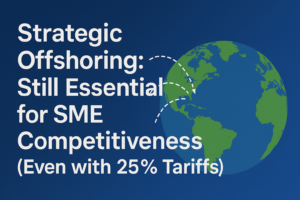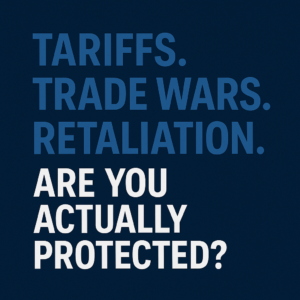
Executive Summary
President Trump’s recent executive orders imposing substantial tariffs on imports from China, Canada, and Mexico have sent shockwaves through the U.S. manufacturing sector. This white paper examines the potential devastating impacts of these tariffs on American manufacturers and presents a compelling case for urgently seeking alternative manufacturing solutions in tariff-free zones such as Vietnam and India.
The implementation of a 25% tariff on goods from Canada and Mexico, coupled with an additional 10% tariff on Chinese imports, threatens to disrupt established supply chains, increase production costs, and ultimately undermine the competitiveness of U.S. manufacturers in the global market. With retaliatory measures already announced by affected countries, the situation is poised to escalate into a full-blown trade war with far-reaching consequences for the American economy.
This paper will delve into the specifics of the tariffs, analyze their potential impacts across various manufacturing sectors, and explore the urgent need for U.S. companies to diversify their manufacturing base to tariff-free zones to mitigate risks and maintain competitiveness.
The Tariff Landscape: A Perfect Storm
Trump’s Tariff Offensive
President Trump’s recent executive orders have set the stage for a dramatic shift in U.S. trade relations with its largest trading partners. The tariffs, set to begin on March 1, 2025, include:
- 25% tariff on goods from Canada and Mexico
- 10% tariff on imports from China
- 10% tariff on Canada’s energy resources1
These measures, ostensibly aimed at curbing the flow of fentanyl and illegal immigration, represent a significant departure from the free trade principles that have underpinned U.S. economic policy for decades.
Retaliatory Measures
The international response to these tariffs has been swift and severe. China has already imposed retaliatory tariffs, including:
- 15% tariff on coal and liquefied natural gas
- 10% tariff on crude oil, agricultural machinery, and some cars1
Canada, under Prime Minister Justin Trudeau, has announced a two-phase retaliation plan, imposing a 25% tax on $155 billion worth of U.S. imports, including:
- Pulp and paper products
- Steel and aluminum products4
These retaliatory measures are likely to exacerbate the economic impact on U.S. manufacturers, creating a vicious cycle of escalating trade barriers.
The Economic Fallout: A Manufacturing Nightmare
Skyrocketing Production Costs
The implementation of these tariffs is expected to have a severe impact on U.S. manufacturing costs. According to the National Association of Manufacturers, “A 25% tariff on Canada and Mexico would add an estimated $144 billion a year to the cost of manufacturing in the U.S.”1 This staggering increase in production costs threatens to erode profit margins and undermine the competitiveness of American manufacturers in both domestic and international markets.
Supply Chain Disruptions
The tariffs threaten to upend the very supply chains that have made U.S. manufacturing globally competitive. Jay Timmons, President and CEO of the National Association of Manufacturers, warns, “A 25% tariff on Canada and Mexico threatens to upend the very supply chains that have made U.S. manufacturing more competitive globally. The ripple effects will be severe, particularly for small and medium-sized manufacturers that lack the flexibility and capital to rapidly find alternative suppliers or absorb skyrocketing energy costs.”1
Sector-Specific Impacts
Different manufacturing sectors will be affected to varying degrees:
- Automotive Industry: With complex supply chains spanning North America, the automotive sector is particularly vulnerable to these tariffs. The increased costs of components and raw materials could lead to higher vehicle prices and reduced competitiveness.
- Electronics Manufacturing: The 10% tariff on Chinese imports will significantly impact the electronics sector, which relies heavily on components and assemblies from China.
- Chemical and Plastics Industry: The Society of Chemical Manufacturers & Affiliates has expressed concern about the tariffs undermining access to critical raw materials1.
- Packaging Industry: Canada’s retaliatory tariffs specifically target pulp, paper, and plastic packaging materials, which could severely impact U.S. packaging manufacturers4.
Economic Ripple Effects
The impact of these tariffs extends beyond direct manufacturing costs:
- Job Losses: As manufacturers struggle with increased costs, job cuts may become inevitable, particularly in small and medium-sized enterprises.
- Consumer Price Inflation: The Consumer Brands Association warns of potential grocery inflation as tariffs on imported goods, especially those unavailable in the U.S., could result in higher prices for consumers4.
- Export Market Losses: Retaliatory tariffs from Canada, Mexico, and China could severely impact U.S. exporters, leading to lost market share in these crucial markets.
The Urgent Need for Alternative Manufacturing Solutions
Given the dire outlook for U.S. manufacturing under these tariffs, it is imperative that companies explore alternative manufacturing solutions in tariff-free zones. Two countries stand out as particularly attractive options: Vietnam and India.
Vietnam: A Rising Manufacturing Powerhouse
Vietnam has emerged as a prime destination for manufacturers looking to diversify their supply chains away from China. The country offers several compelling advantages:
- Extensive Free Trade Network: Vietnam is party to 17 Free Trade Agreements, providing access to a vast network of preferential trade relationships5.
- Robust Industrial Zones: Vietnam boasts over 250 industrial and export processing zones across four major economic regions, offering specialized infrastructure and incentives for various manufacturing sectors2.
- Attractive Tax Incentives: Vietnamese free zones offer significant tax benefits, including:
- 10% reduction in corporate income tax for up to 15 years
- 100% corporate income tax exemption for up to four years for approved projects
- 50% reduction in personal income tax for both local and foreign employees3
- Lower Operating Costs: Vietnam offers competitive advantages in terms of labor and utility costs. For example, electricity prices in Vietnamese free zones average $0.082 per kilowatt hour, compared to $0.101 in Indonesia or $0.112 in Thailand3.
- Strategic Location: Vietnam’s proximity to major Asian markets and its coastline facilitate efficient logistics and distribution.
India: A Vast Market with Growing Manufacturing Capabilities
While not explicitly mentioned in the search results, India represents another viable alternative for U.S. manufacturers:
- Large Domestic Market: India’s vast population and growing middle class offer significant opportunities for manufacturers to serve both domestic and export markets.
- Skilled Workforce: India boasts a large pool of skilled workers, particularly in sectors like IT, engineering, and pharmaceuticals.
- Government Initiatives: Programs like “Make in India” have been designed to attract foreign investment and boost the country’s manufacturing sector.
- Improving Infrastructure: Ongoing investments in ports, roads, and industrial corridors are enhancing India’s manufacturing and logistics capabilities.
Urgent Action Plan for U.S. Manufacturers
Given the imminent threat posed by the tariffs, U.S. manufacturers must act swiftly to protect their interests. Here’s a proposed action plan:
- Immediate Risk Assessment: Conduct a thorough analysis of your supply chain to identify vulnerabilities to the proposed tariffs.
- Explore Vietnamese and Indian Options: Begin researching and reaching out to potential contract manufacturers in Vietnam and India. Focus on those located in free trade zones or special economic zones.
- Leverage Free Trade Agreements: Familiarize yourself with the free trade agreements of Vietnam and India to identify potential tariff advantages for your products.
- Diversify Supply Chains: Start the process of diversifying your supply chain to reduce reliance on tariff-affected countries. This may involve a combination of reshoring, nearshoring, and offshoring strategies.
- Invest in Automation: To offset potential increases in labor costs, consider investing in automation technologies to improve efficiency and reduce reliance on manual labor.
- Engage with Policymakers: Join industry associations in lobbying efforts to highlight the negative impacts of these tariffs on U.S. manufacturing and the broader economy.
- Develop Contingency Plans: Prepare for various scenarios, including the possibility of escalating trade tensions and additional tariffs.
Conclusion: A Call to Action
The proposed tariffs on China, Canada, and Mexico represent an existential threat to the competitiveness and viability of U.S. manufacturing. The potential for skyrocketing production costs, supply chain disruptions, and retaliatory measures creates a perfect storm that could devastate American industry.
The urgency of the situation cannot be overstated. U.S. manufacturers must act now to explore alternative manufacturing solutions in tariff-free zones like Vietnam and India. These countries offer attractive incentives, established industrial infrastructure, and access to growing markets that can help American companies weather the impending tariff storm.
By diversifying manufacturing bases, leveraging free trade agreements, and adapting to the changing global trade landscape, U.S. manufacturers can not only survive this crisis but potentially emerge stronger and more competitive on the world stage.
The clock is ticking. The time for action is now. The future of U.S. manufacturing hangs in the balance.
Youtube
Instagram
Linkedin
Facebook-f
#QualityControl #VietnamManufacturing #Manufacturing2024 #OffshoreManufacturing #REDUxEngineering #QualityAssurance #ManufacturingTips #TechInManufacturing #AuditProcess #InspectionProcess






